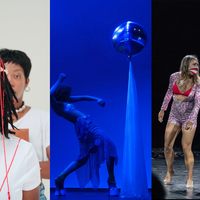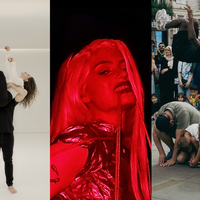Sat 11 Jan: David Ainsworth, Banquet Theatre and Excessive Human Collective

News Story
David Ainsworth’sSignature Moves, concerns his journey with Parkinson’s. The work begins with arms wringing and squeezing anxiously before giving way to a tai-chi flow, meditative and present. Among the performers of mature ensemble Fuse Dance Collective are others with Parkinson’s, bringing to Resolution experiences and bodies that are otherwise far too rare on stage. The cast show great care for each other: lending hands of support, exchanging knowing glances as they do-si-do. While simple in its choreography, it’s this humanity that wins us over.
Excessive Human Collective’s sci-fi romp through the pink void is an enigmatic exploration of femininity for the ChatGPT generation. We Are The World is bold and dynamic, oscillating between the natural and the uncanny. Choreographer Imogen Reeve shows some curious innovations with the AI aesthetic in the piece, limbs ripple and twitch while faces flicker with unnatural, flirty expressions. Once the dirty bassline kicks in the dancers’ articulations become fuller, punctuating the beat with hair-whips and beauty queen waves. Hannah Durkan is especially magnetic as an eerie robo-Marilyn Monroe. The work is relevant, political but not preachy, even a little cheeky. A Philip K. Dick story in a post-brat world.
The infamous Monty Python sketch Mr. Creosote serves as inspiration for Feeding Time, a camp study on greed and consumption. A gang of Cleese-esque waiters emerge, dressed in briefs, aprons, and fisting gloves. They’re on the charm offensive, lathering their delighted victim in whipped cream and confetti while a weary janitor gazes on from the distance. What follows is a string of vignettes: a delightfully naff pasodoble, a flock of vultures picking at a corpse, a baby learning to walk. If it sounds like a lot that’s because it is. Director Mark Crawley wants to say a great deal with this piece, which only weakens the punch. His Banquet Theatre is a young, animated ensemble, and seems glad to throw things against the wall and see what sticks — a bit like the innards of Mr. Creosote at his explosive demise.
- Eoin Fenton
Andy Warhol posited, “isn’t life a series of images that change as they repeat themselves?” David Ainsworth’sSignature Moves seems to think so. Performed by 15 dancers with Parkinsons and other neurological conditions, it centres around a repeated motif of arm sweeps and presses. At one point, dancers execute them in a confrontational arrow formation, rock music imbuing their motions with angsty determination. Later, soft blue lighting and acoustic guitar notes create a meditative atmosphere, the performers moving with the fluid grace of tai chi practitioners. The result is more abstract than narrative, and the story Ainsworth wanted to tell of “an individual who is dealing with illness” remains ambiguous. However the smiles shared between dancers undeniably create a charming onstage community, demonstrating the power of movement to connect and uplift during difficult times.
Banquet Theatre’sFeeding Time also feels like a collection of images. Inspired by Monty Python’s Mr Creosote sketch, they strive to explore relentless human consumption. Some do so effectively: One dancer mindlessly stuffs her face with whipped cream, while another unpacks reams of plastic bags from a large cardboard box, comically unearthing a pair of rubber gloves identical to the ones he is already wearing. Yet moments in which performers obsessively wash their hands and run in clumsy curving pathways, arms outstretched like wings, feel out of place. Director Mark Crawley clearly had many different ideas for Feeding Time—I look forward to seeing how he finds clearer connections between them in the future.
The stand out piece of the night comes from Excessive Human Collective. Taking feminist theorist Donna Haraway’s musings on cyborgs as a point of departure, We Are The World sees dancers Allegra Vistalli, Jorden Brooks, and Hannah Durkan punctuate torso undulations, lioness-like crawls, and effortless leg extensions with glitch-like jolts and shudders. While their vacant eyes and suggestively open-mouthed expressions are reminiscent of idealised female avatars seen online, their toga-like dresses and relaxed, asymmetrical poses evoke Classical painting and sculpture. By alluding to both the historical and contemporary, choreographer Imogen Reeve cleverly suggests that male fantasies continue to place unrealistic, reductive expectations on women. When will the glitches become so overwhelming that we finally break free from them?
- Emily May


